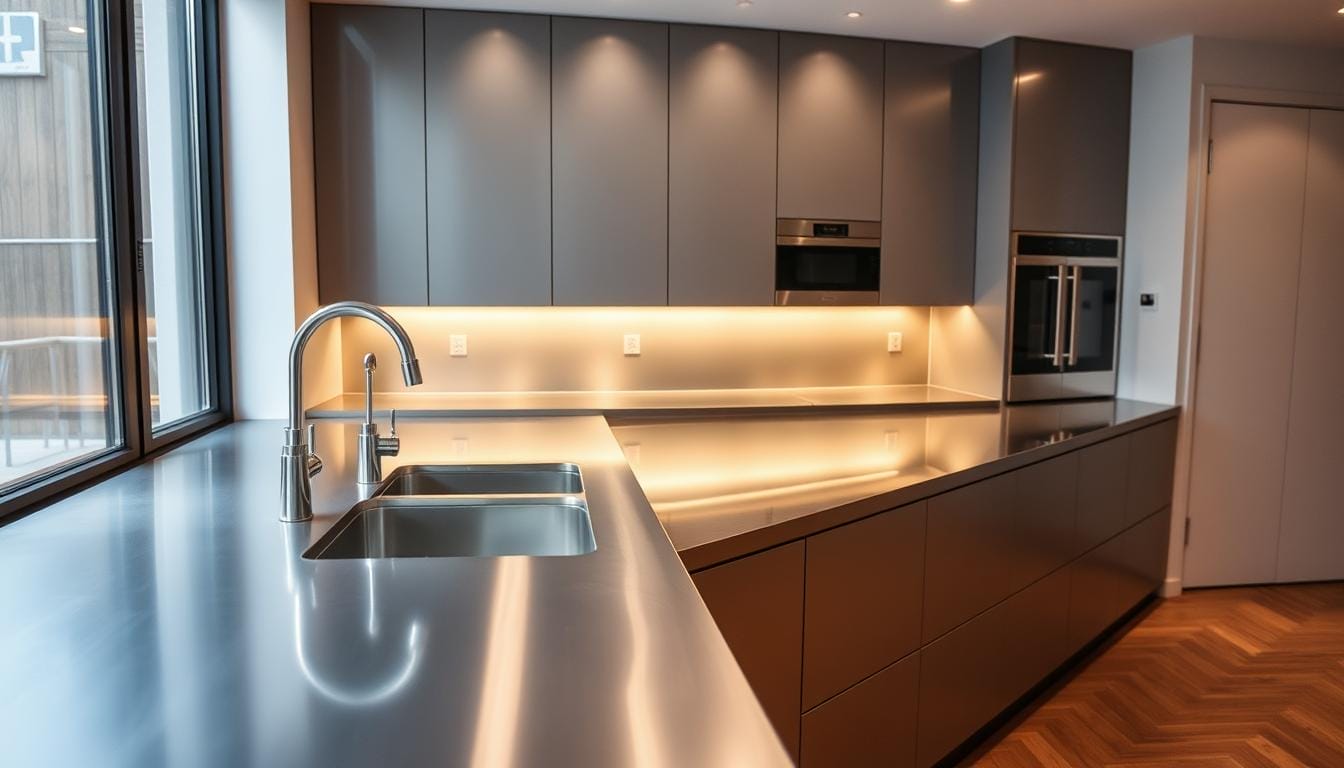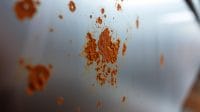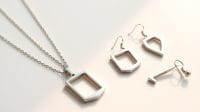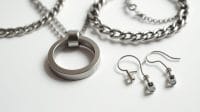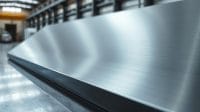Curious which kitchen surface blends commercial toughness with modern style—and is it the right choice for your home?
This buyer’s guide explains what stainless options are, who they suit, and how they compare for a modern kitchen upgrade or a commercial retrofit.
Material choices matter: 304 (18/8) fits most homes and businesses, while 316L offers extra corrosion resistance for coastal or humid sites. Gauge ranges—16, 14, 12, 11—show how thicker sheets resist dents and last longer.
Finishes shape both look and wear: #4 brushed matches appliances, matte hides light scratches, and textured patterns mask daily marks. Standard sizes speed delivery; full custom work accepts AutoCAD, SolidWorks, and SketchUp files for complex cutouts and integrated sinks.
Expect standard substructures like moisture-resistant MDF, poplar plywood, or stainless channel for quiet, code-compliant installation. Professionals handle welded seams and tight tolerances, though advanced DIY is possible with planning.
This short intro sets the stage: the guide will weigh pros and cons, specs, installation steps, cost tips, and maintenance so readers make a confident choice.
Buyer’s overview: why stainless steel fits modern kitchens and commercial spaces
Professional kitchens pick metal surfaces for a reason: durability under constant heat and heavy use. They resist heat, water, and stains better than most options, making them ideal for food prep, coffee stations, and lab-adjacent tasks.
The look suits modern design: a satin or brushed finish blends with appliances, while matte hides fingerprints and mirror finishes make a bold statement. Warmer cabinets or wood accents can soften the industrial feel.
Thickness matters: heavier gauges (14–16) reduce dents and oil-canning in both commercial and residential settings. Underlayment and sound deadening cut the characteristic ring of utensils and improve tactile comfort.
- Performance: withstanding high heat and frequent cleaning without warping.
- Design: multiple finishes for cohesive appearance and easy maintenance.
- Practicality: inert metal resists acids and water, extending service life.
Consider cooking volume, cleaning routine, and integrated elements—backsplashes, welded corners, and cutouts—before moving to specs and budget. The material is also fully recyclable, which supports long-term sustainability.
Key pros and cons to weigh before you buy
Before you commit, compare the real-world benefits and trade-offs of a metal work surface. This helps match performance to the room’s use and style.
Durability under heat, water, and stains: Metal tops handle hot pans without scorching and resist common kitchen acids and spills. They stand up to frequent cleaning and heavy use, which makes them popular in both homes and light commercial applications.

Hygiene and seamless fabrication: Fully welded corners and minimal seams reduce trapping and simplify sanitation. The nonporous nature supports routine cleaning—wipe with the grain using a microfiber cloth for best results.
- Pro — thermal resilience: place hot cookware right on the surface.
- Pro — moisture and stain resistance: fewer rings and stains than porous options.
- Pro — sanitation: welded joins limit crevices and speed cleaning.
- Con — scratching: utensils and grit will mark the finish; brushed or matte finishes hide this better.
- Con — noise & feel: pots clatter and the touch can feel cool; sound-deadening backers help.
- Con — perceived appearance: the look can read industrial; pairing with wood or color softens it.
Care and longevity: Use cutting boards rather than cutting directly on the sink or work area. Light buffing reduces minor marks. With reasonable maintenance, service life often exceeds 20 years, making total cost of ownership competitive despite higher upfront pricing.
Stainless steel countertops: materials, finishes, and construction specs
A precise spec—grade, gauge, and backing—translates directly to durability and service life. Choose the right alloy and build to match use, environment, and appearance goals.

304 vs 316L: alloy choice
304 (18/8) is the standard for most interior kitchens and food service areas. It balances cost and corrosion resistance.
316L marine-grade is recommended where salt air, chlorine, or persistent humidity are present.
Gauge and strength
Common sheet gauges: 16, 14, 12, and 11. A 16 gauge is a robust residential baseline.
Specify 14–11 gauge for heavy-use or commercial zones to reduce dents and oil-canning.
Finishes, edges, and backers
Finish options include #4 brushed, matte, scratch-hiding textures, and mirror. A brushed finish hides small marks and matches appliances well.
Edge profiles: standard square for clean lines, or a marine edge to retain spills. A 4-inch welded backsplash minimizes crevices and eases cleaning.
- Backers: moisture-resistant MDF, 1½” poplar plywood (two ¾” layers), or 16-gauge 304 channel for all-metal builds.
- Accessories: integral welded sinks, drainboards, and reinforced under-cuts are available to tight tolerances.
Installation pathways and what to expect on project day
Day-of installation moves from drawings to action—expect coordinated timing and careful site prep. The fabricator will confirm drawings, then the crew performs a dry-fit to check reveals and fastener locations.
Professional vs. advanced DIY: Hire pros for field templating, large single-piece tops, welded seams, or factory-formed sinks. Skilled DIYers can install simple runs over plywood backers when templates and tools are precise.
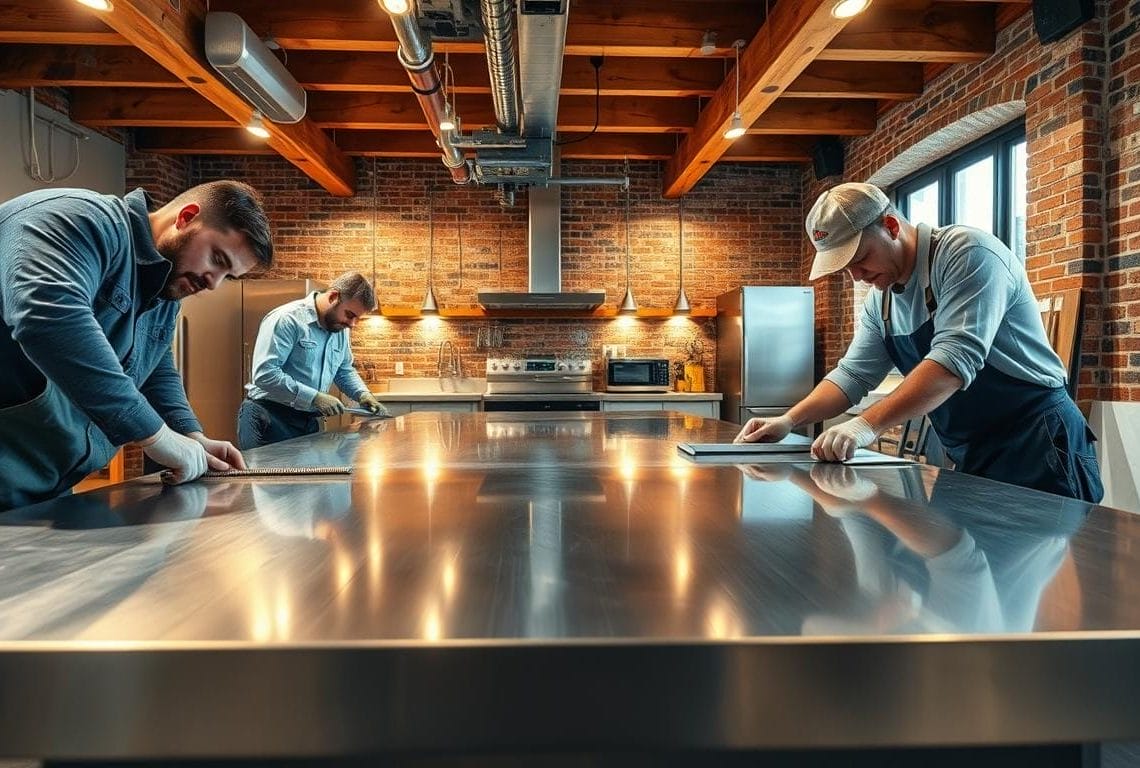
Substructure and sound control
Level cabinets, confirm squareness, and choose a backer: MDF, layered plywood, or metal channel. Add hat channels and sound-deadening layers for flatter planes and less ringing under heavier gauges.
Seams, sinks, and backsplash integration
Wrapped edges give a clean perimeter. Fabricators often supply factory-welded sinks and coved 4-inch backsplashes to reduce joints and improve sanitation. Cutouts for ranges and faucets are templated and finished to match the chosen finish.
- Lead time & fabrication: approvals trigger engineering, forming, welding, finishing, and quality checks before crating for shipping.
- Jobsite readiness: clear paths, protected floors, plumb wall for the backsplash, and appliance timing matter.
- Delivery tips: schedule lift assistance, inspect crates on arrival, and document freight damage before sign-off.
Final step: dry-fit, secure the piece, seal transitions at the wall, and perform an initial with-the-grain wipe-down to condition the finish.
Costs, budgeting, and ways to optimize your spend
Costs fluctuate widely—know which specs push the price up fast.
Typical price range: Expect entry pricing near $60 per square foot for basic runs. Prices rise with thicker gauge, premium grade, complex edges, and integrated sinks or coved returns.

What drives price
- Alloy and grade: 304 vs 316L affects corrosion resistance and cost.
- Gauge & finish: heavier gauge and specialty finishes add material and labor.
- Complexity: marine edges, welded bowls, and many cutouts increase shop hours.
Value strategies
Use metal only where it adds the most value—prep zones and islands make strong focal points while other runs use lower-cost options.
Work with a local metal shop or source prefab sizes to reduce markups and lead time. Repurposed restaurant tables can be an affordable island top if dimensions fit.
When you request a quote: include grade, gauge, finish, edge profile, backsplash height, cutout count, and estimated quantity. Ask for line-item pricing (material, finishing, cutouts, install) and factor in crating and shipping.
Budget tip: hold a 10–15% contingency for field adjustments and unexpected install time.
Care and maintenance for a long-lasting surface
A simple routine keeps a metal work surface looking and performing like new. Regular, light upkeep prevents common wear and preserves the original appearance.
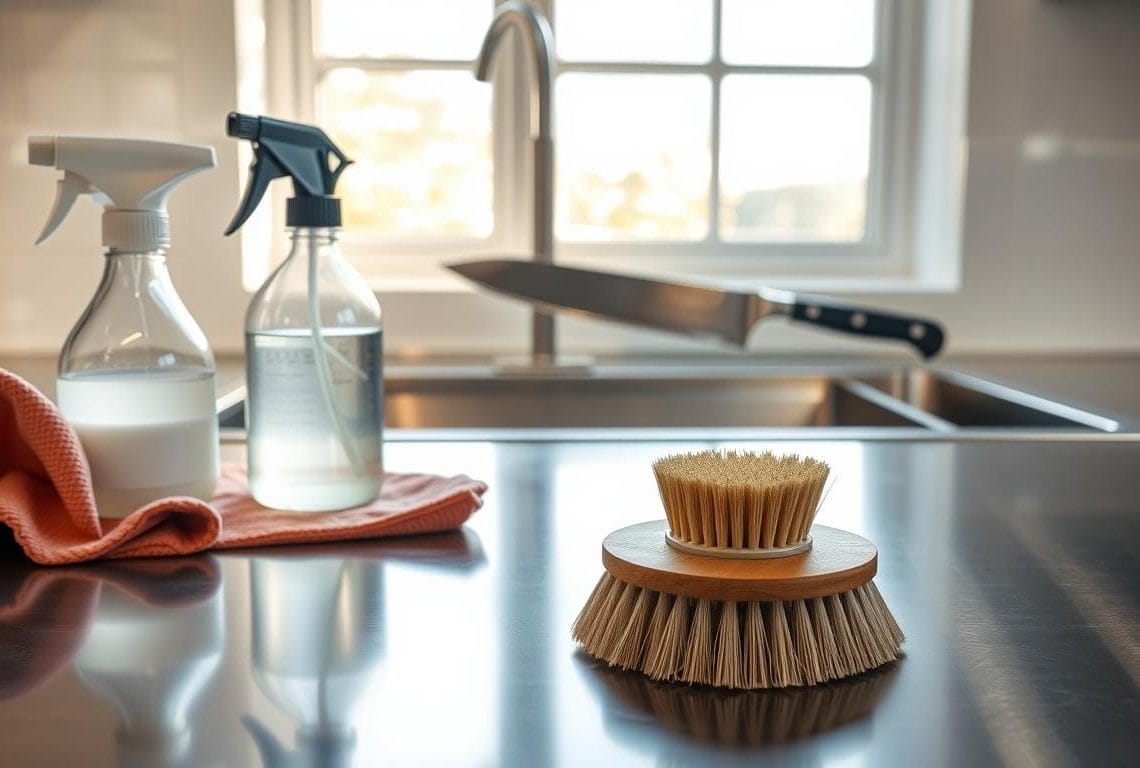
Daily cleaning
Quick and consistent. Use a damp microfiber cloth and wipe with the grain to remove fingerprints and water spots. This short pass protects the finish and reduces the need for heavy cleaning.
Once weekly, apply a specialty stainless cleaner sparingly, then buff dry to reduce streaks and build a uniform sheen across the countertop.
Scratch management and patina
A brushed finish accepts micro-scratches and develops a lived-in patina. Light buffing along the grain evens texture in high-use zones.
Protect edges and the sink area with cutting boards and soft mats to limit dents from dropped utensils.
Do’s and don’ts
- Do: set hot pans down—the metal resists heat; avoid dragging cast iron to prevent deep gouges.
- Do: wipe standing water near the sink to cut mineral spotting, especially in hard-water areas.
- Don’t: cut directly on the countertop; use boards to protect the top and corner radii.
- Don’t: expose the top to prolonged chlorides or undiluted bleach; rinse and dry after any chemical contact.
Periodic checks: inspect caulk lines at the backsplash and confirm fasteners remain secure. Thicker gauge panels resist denting and help the surface stay flat under daily impacts.
Toolkit suggestion: keep microfiber cloths, non-scratch pads, and one dedicated polish on hand for predictable, fast maintenance. With modest care, these metal countertops can last 20+ years.
Applications across residential, commercial, and industrial environments
What you plan to do on the top—cook, test, or assemble—dictates grade, backing, and edge details.
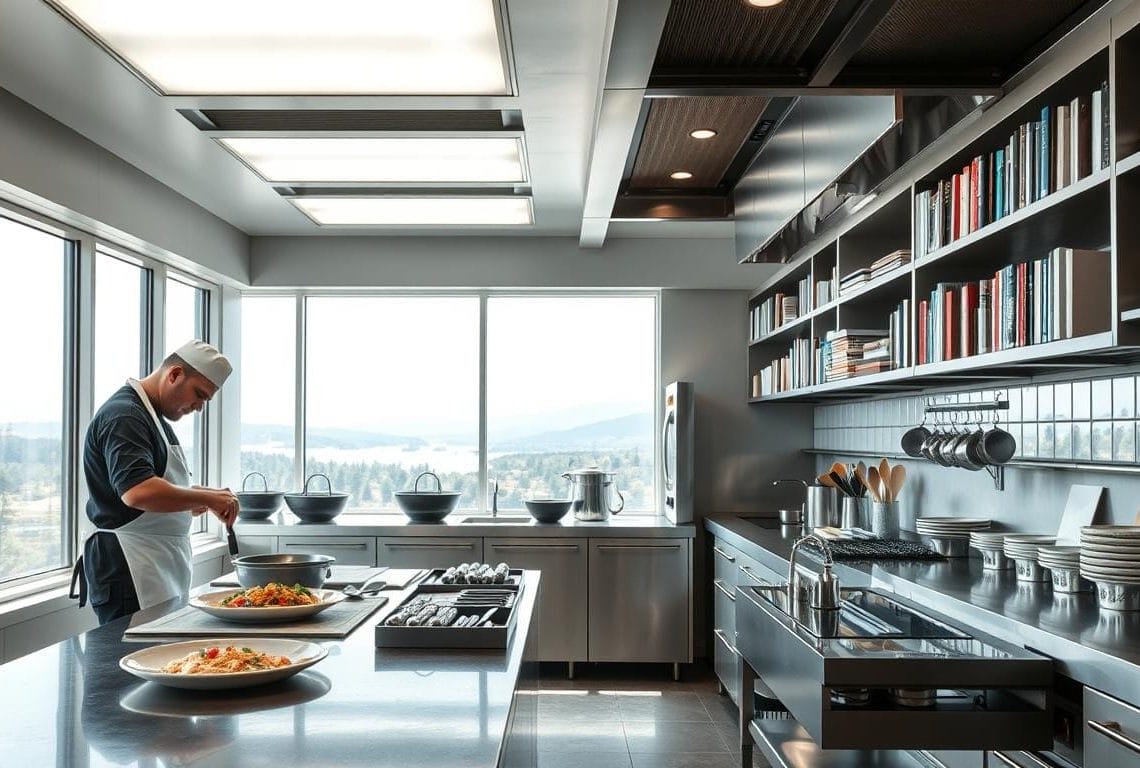
Home kitchens, islands, and matched backsplashes
Residential installs suit islands and prep zones that see heavy use and frequent cleaning.
Matched backsplash and wall panels create a unified look and simplify sanitation. Typical builds use 16 GA #304 with hat-channel backers for flatness and reduced ringing.
Healthcare, labs, and pharmaceutical facilities
Nonporous surfaces and welded joins meet sterilization needs in hospitals and compounding rooms.
Specifiers often ask for coved 4-inch backsplashes and fully welded bowls for easy disinfection and minimal seams.
Food service, bakeries, and commercial kitchens
High-throughput prep lines rely on durable tables and continuous runs that resist acids and frequent washdowns.
Marine edges, reinforced sink areas, and integral drainboards keep stations functional under heavy daily use.
Manufacturing, workshops, and R&D spaces
In maker spaces and light industry, these surfaces serve as work tables, test benches, and equipment landings.
Options include L-shaped layouts, under-counter reinforcement, and mechanical joints to adapt to specific equipment and workflow.
- Design cohesion: matching finish across counters, splash, and panels reduces cleaning time and unifies the space.
- Outdoor or wet environments: choose higher-grade alloys and sealed backers for extended durability.
- Lifecycle value: in busy operations, long service life and fast cleaning lower total cost of ownership.
Design and specification checklist to request an accurate quote
A clear, consolidated request reduces questions and accelerates approvals. Start with a short cover that states project scope, site address, and desired install window.
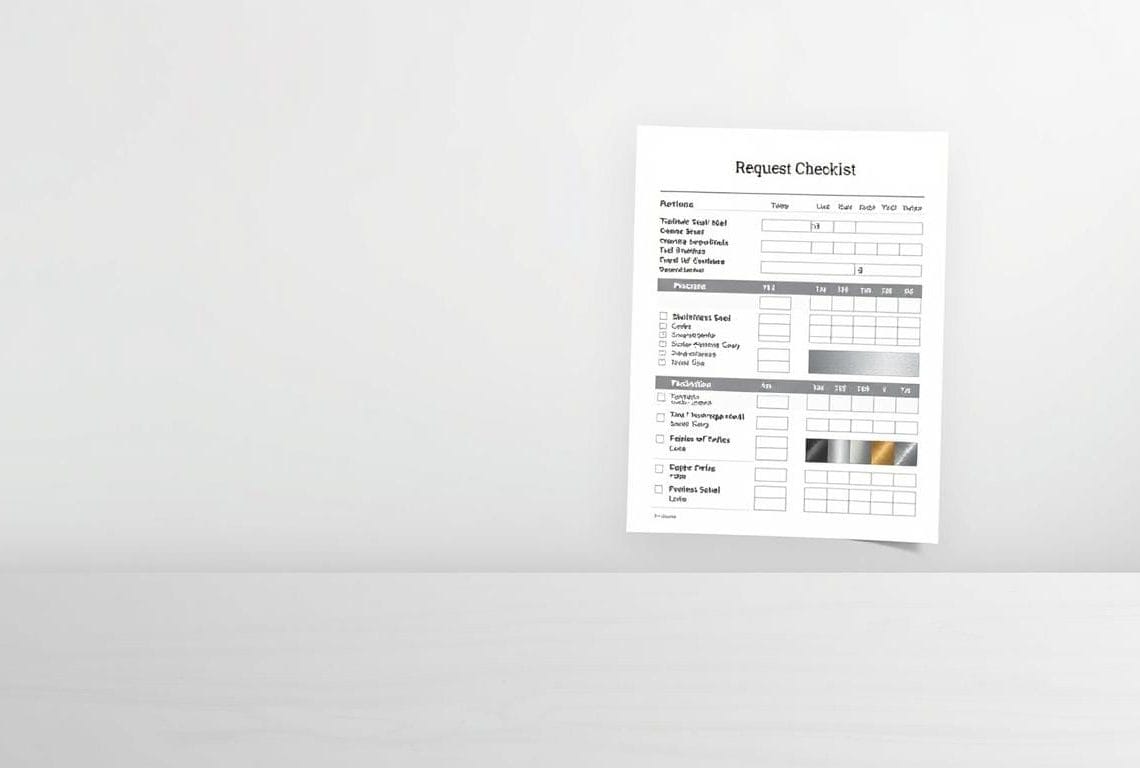
Core specs to include
Material line items: list 304 or 316L, desired gauge, and exact finish so estimators can price material and fabrication accurately.
Edge and spill control: specify square or marine edge, backsplash height (for example 4 inches), and any coved transitions up the wall.
Wet zone details: provide sinks bowl sizes, centerlines, faucet hole diameters, and accessory cutouts to avoid field changes.
Layout, drawings, and tolerances
Layout notes: indicate overall lengths, depths, corner angles, and whether the run is straight, L-shaped, or needs mechanical joints.
Reinforcement: call out heavy loads and under-counter reinforcement where equipment may cause deflection.
- Backer selection: choose moisture-resistant MDF, poplar plywood, or 16-gauge channel based on exposure.
- File submission: upload clean drawings in .dwg, .dxf, .step, .pdf, .jpg, etc., under 5MB with unique filenames and no apostrophes.
- Installation notes: flag site constraints—stairwells, elevators, tight turns—and the preferred install window for crew planning.
Final tip: consolidate grade, finish, gauge, sinks, backsplash, and layout in a single packet to speed pricing. A precise request gets the fabrication timeline moving and reduces on-site changes to the countertop and adjacent panels.
Next steps: move from inspiration to fabrication with confidence
Move from idea to build: finalize grade (304 or 316L), gauge, edge profile, and the chosen finish. Decide where the metal top is most useful—full runs, an island, or busy prep zones—to match the room’s workflow and the desired look.
Prepare accurate drawings and upload CAD or images with cutouts, quantities, and timing. Submit a complete request so shops can supply firm pricing, lead times, and options like marine edges, welded sinks, and L-shapes.
Before delivery: level and protect cabinet bases, confirm wall plumb for the 4-inch backsplash, and line up installers. Stock microfiber cloths and a recommended cleaner to begin proper maintenance immediately.
Final step: review shop drawings, inspect the finished surface on arrival, note seam and reveal alignment, then sign off and enjoy a durable, sanitary top that matches your design intent.
